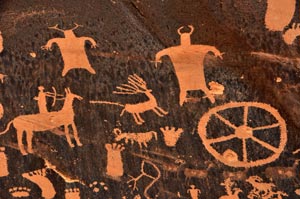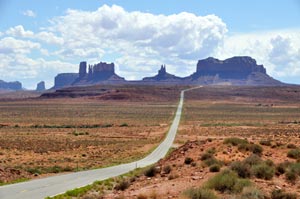Land of the Ancients
While signs of America’s ancient past are scattered across the southwest, from ancient cliff dwellings and petroglyphs to arrowheads and pottery shards, the Four Corners area bordering the states of Utah, Arizona, New Mexico and Colorado is renowned as a center of that activity, and most importantly contains most of the prominent examples of what remains.
How you go about this trip, depends a lot on how much time you have, and whether you are focused on seeing ancient ruins or have other sites on your itinerary. The Four Corners is one of those areas of the Southwest where it doesn’t really matter where you are coming from, the time to get there from major international airports and see it all is probably going to be about same.
Newspaper Rock State Historic Monument (Utah) – Located on the road (Highway 211) to Canyonland’s Needles District, newspaper rock is one of the best (and largely undamaged) panels of ancient Indian rock art (also known as petroglyphs) that still exists. A trip to this area would not be complete without seeing it.
Mule Canyon/Kane Gulch/Grand Gulch (Utah) – Located on the Highways (95, 261) leading to Natural Bridges National Monument are three canyons filled with ancient cliff dwellings. Of the sites I recommend below this one is the most physically demanding, and should be avoided if you have never walked long distances under the hot desert sun. But for those with both the time and experience necessary, a visit to one or more of these canyons is an experience not to be missed.
Hovenweep (Utah) – Given its out of the way location, and better preserved examples of ancient ruins to the east and south, I would only recommend a visit here if you have some extra time, or are planning on taking the “scenic route” to Mesa Verde.
Mesa Verde National Park (Colorado) – To me Mesa Verde represents the crown jewel of the ancient Southwest. Its very accessible nature, and well preserved monolithic architecture are a must see for those interested in the ancient cultures of the Southwest.
Monument Valley (Utah/Arizona) – While primarily known for its monolithic sandstone landscape, this area is part of the homeland of some of the descendants of the Native Americans that inhabited the Four Corners region. The other prominent group are the Puebloan peoples of New Mexico.
Canyon De Chelly (Arizona) – is a unit of the National Park System administered entirely on land owned by the Navajo, and protects the cultural heartland of the Navajo as well as a number of ancient ruins.
Navajo National Monument (Arizona) – preserves three of the most intact cliff dwellings of the ancestral puebloan people. These dwellings include Keet Seel Betatakin, and the Inscription House site. Inscription House is currently closed to public access. This monument is located on the Navajo Reservation.
Aztec Ruins National Monument (New Mexico) – protects a serious of ancient Puebloan structures. It is located near the town of Farmington in the Northwest corner of New Mexico. If you are in the area to visit Chaco Canyon, and/or Mesa Verde it is worth adding this as part of smaller version of the “Land of Ancients” Trips.
Chaco Canyon National Monument (New Mexico) – Chaco Canyon represents one of the ancient epicenters of Indian culture in the Southwest. While its ruins are not as well preserved or or as visually stunning as Mesa Verde, its cultural, technological and scientific significance is probably only outmatched by the ancient cultures of the Maya, Aztecs and Inca far to the south.

